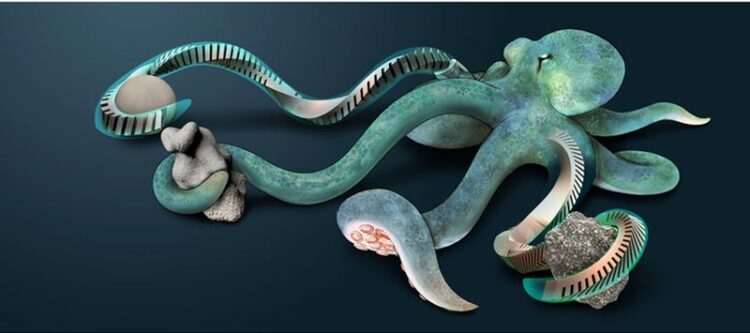Robotic manipulators inspired by nature

Flexible tentaclelike manipulators driven by air pressure and inspired by nature designed to grasp and manipulate a variety of soft objects
Credit: Dong Wang
Flexible tentaclelike manipulators driven by air pressure can be designed to grasp, manipulate soft objects.
Traditional robots can have difficulty grasping and manipulating soft objects if their manipulators are not flexible in the way elephant trunks, octopus tentacles, or human fingers can be.
In Applied Physics Reviews, by AIP Publishing, investigators from Shanghai Jiao Tong University in China developed a type of multiple-segment soft manipulator inspired by these biological systems. The soft manipulators are based on pneu-nets, which are pneumatically actuated elastomeric structures.
These structures have a tentaclelike shape and consist of a series of connected internal chambers which can be inflated pneumatically, blowing them up like a balloon. One side of the tentacle is highly flexible while the other is stiffer. Increasing air pressure to the chambers causes the structure to bend toward the stiff side.
“We have designed soft manipulators using a mathematical model that can follow a particular 3D spatial trajectory,” said author Dong Wang. “Our soft manipulator consists of multiple segments where each segment shows a different actuation mode — twisting, in-plane bending, or helical actuation — by choosing different chamber orientations.
“The key advance of this work is the development of a mathematical methodology that can automatically design soft manipulators matching complex 3D trajectories upon single pressurization.”
The group designed manipulators for a variety of 3D trajectories by varying the geometric, material, and loading parameters for their pneu-net structures. They were able to do an inverse design to create a manipulator that would follow a specific trajectory.
The design method relies on a mathematical model that is much less costly to use than traditional computational models. The group confirmed their mathematical technique produced manipulator designs with behaviors similar to computational models. They validated their results using simple experiments.
“To achieve truly versatile applications of the designed soft manipulators, more work is needed,” said author Guoying Gu.
Among this future work are strategies to extend the approach to systems with multiple actuators. In addition, the inverse design process is still not fully automatic, since the first stage of the process requires a human operator choose the regions of the curve that are assigned to twisting, bending, or helical deformation.
“We can envision an automated system to do this step using machine learning or other methods,” said Gu.
This work should have applications in robotic grippers, implantable and wearable devices, and robots moving through unpredictable terrains.
The article “Modeling and inverse design of bio-inspired multi-segment pneu-net soft manipulators for 3D trajectory motion” is authored by Chengru Jiang, Dong Wang, Baowen Zhao, Zhongkun Liao, and Guoying Gu. The article will appear in Applied Physics Reviews on Dec. 21, 2021 (DOI: 10.1063/5.0054468). After that date, it can be accessed at https://aip.scitation.org/doi/full/10.1063/5.0054468.
ABOUT THE JOURNAL
Applied Physics Reviews features articles on significant and current topics in experimental or theoretical research in applied physics, or in applications of physics to other branches of science and engineering. The journal publishes both original research on pioneering studies of broad interest to the applied physics community, and reviews on established or emerging areas of applied physics. See https://aip.scitation.org/journal/are.
Journal: Applied Physics Reviews
DOI: 10.1063/5.0054468
Article Title: Modeling and inverse design of bio-inspired multi-segment pneu-net soft manipulators for 3D trajectory motion
Article Publication Date: 21-Dec-2021
Media Contact
Larry Frum
American Institute of Physics
media@aip.org
Office: 301-209-3090
All latest news from the category: Physics and Astronomy
This area deals with the fundamental laws and building blocks of nature and how they interact, the properties and the behavior of matter, and research into space and time and their structures.
innovations-report provides in-depth reports and articles on subjects such as astrophysics, laser technologies, nuclear, quantum, particle and solid-state physics, nanotechnologies, planetary research and findings (Mars, Venus) and developments related to the Hubble Telescope.
Newest articles

Innovative 3D printed scaffolds offer new hope for bone healing
Researchers at the Institute for Bioengineering of Catalonia have developed novel 3D printed PLA-CaP scaffolds that promote blood vessel formation, ensuring better healing and regeneration of bone tissue. Bone is…

The surprising role of gut infection in Alzheimer’s disease
ASU- and Banner Alzheimer’s Institute-led study implicates link between a common virus and the disease, which travels from the gut to the brain and may be a target for antiviral…

Molecular gardening: New enzymes discovered for protein modification pruning
How deubiquitinases USP53 and USP54 cleave long polyubiquitin chains and how the former is linked to liver disease in children. Deubiquitinases (DUBs) are enzymes used by cells to trim protein…


